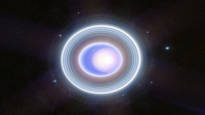A more recent image from the James Webb Space Telescope also shows the Zeta ring and details of the ice cap.
The US and European space agencies have published a new image of the observations made by the James Webb space telescope.
The image taken by the Webb telescope at an infrared wavelength reveals more detailed details than before of the gas rings of Uranus and its surrounding moons.
The image expands on a two-color image of the planet released earlier in April this year. The new image combines measurements of visible light and infrared radiation, i.e. thermal radiation.
The wavelength of visible light is 380−750 nanometers. Infrared radiation is light invisible to the human eye, with a wavelength of approximately 700 nanometers to one millimeter.
Uranus is tilted more than 90 degrees, which is why its climatic conditions in different seasons are extreme. The telescope has been able to record Uranus’ dim inner and outer rings, including the elusive Zeta ring, which is closest to the planet but is very dim and diffuse.
The space telescope also captured many of the planet’s 27 known moons, even some small moons inside the rings. The image taken with an infrared wavelength also shows the gas rings surrounding the ice cap more clearly than before.
The James Webb telescope, built in cooperation between NASA, ESA and the Canadian Space Agency, was launched into space in 2021.
